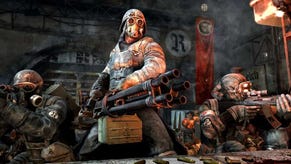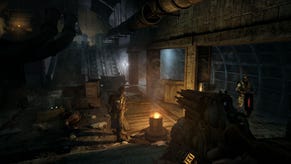Buried Treasure: The heartbeat of Metro: Last Light
Amid the blinking neons and high-pitched squeals of Tokyo Game Show 2011, one game gave off a darker glow. Scrape back the action-packed veneer to see the soul of Metro: Last Light.
In a dark curtained booth decorated with a faded Moscow map and the disturbingly empty eye sockets of a gas mask, Huw Beynon, THQ's studio communications lead for 4A Games, is playing Metro: Last Light.
He's using an Xbox 360 controller hooked up to a PC, a modest-looking grey box unceremoniously dumped in a corner. But we're not looking at that; it's absolutely essential we never look away from the screen, because every moment of the live code demo offers a spectacle.
It's not just Metro's trademark graphical oomph that keeps us glued; this action-packed demo has little in common with the creepy corridor crawls we associate with Metro 2033.
All the elements of the gamescom demo were there - the fire fight, the crowd, the flight, the train sequence - hardly the tense, survival horror atmosphere of the original game. Once again, THQ has brought out just one small aspect of the greater game.
"The reason we've chosen that is to show the very real improvements we think we've made to some of our core gameplay mechanics - so our combat, our AI, our stealth mechanics, the feel of the weapons," Beynon offered, working the flawed-masterpiece angle.
"The demo was really designed to showcase how we've changed the gunplay, which is an area where we had some fairly valid criticisms with the first game.
"The entire Metro experience is very much going to be there - the slow burn, the survival horror, and the exploration within the stations."
We're promised the sequel will contain at least as much content, if not more, than the original and that the full game will bring a number of "unexpected environments". Depite what we've seen so far, we'll have the chance to explore it all slowly, carefully, and with an eye for survival.
"There'll be plenty of opportunities, as you can with the first level, to play through without killing anyone," Beynon continued.
"We know what our fans really liked about the original. I don't think they need another run and gun shooter."
"This demo is more of a technical showcase, certainly to show how we've changed some of our systems, rather than trying to say 'that's the direction that we've moved to for the game'.
"We know what our fans really liked about the original. I don't think they need another run and gun shooter. Next time we show you the game, we'll hopefully be able to show you the full range of gameplay styles."
Having said that, the explosive set piece events shown in the demo are almost certain to appear in the finished game - but not mashed together into a rollercoaster ride which speaks little of the property's ammo-conserving philosophy.
"To illustrate what we wanted to do, with this demo we took several different parts from around the game and spliced them together to create this sequence," Beynon explained.
"So all these part are actually in the game, but they don't necessarily happen in this order, or in sequence."
I still got it, baby
The scrounging, grasping feel of the first game did come through in the demo, provided we were willing to look a little more closely, whenever we got a peek at the boomsticks, cobbled together out of whatever desperate survivors can salvage.
Beynon said the number of weapons has been "dramatically increased", with a focus on the home built oddities.
"This kind of handmade quality is something that we try to carry into all the original weapons. You saw the chain gun that's belt driven, and you can see the gauge that shows how much power there is in the barrel; as that slows down, your rate of fire drops," he explained.
"You might have seen I managed to jam the home made sub machine gun at the end; there's a pressure valve and a little jet of steam to let you know if you're about to jam it.
"Our weapons designer is actually an mechanical engineer, so a lot of these improvised weapons have a real mechanical base. There's a couple I think we could actually make."
It's important that this aesthetic shines through because one of the fledgling franchise's draw cards is its unique apocalyptic setting. The world of Metro isn't as familiar to English speakers as it is to Eastern Europeans, but like The Witcher, players are beginning to clamour for the source novels in a bid to discover more of the canon.
It seems like an excellent opportunity for cross-promotion, but while Metro 2033 was a direct adaptation of the book of the same name, Last Light bares little resemblance to Metro 2034, the sequel.
"[Author Dmitry Glukhovsky] wrote a follow up which I think by his own admission is a kind of esoteric, arthouse novel that really wouldn't suit any kind of video game adaptation," Beynon explained.
"Instead, Dimitry crafted the overall plot and storyline for Metro Last Light and then the studio has developed the nuts and bolts from that.
"But it's still very much Dmitry's concept and creation and we continue to work closely with him on the story."
The Pretty
At the very end of the demo we're given a moment to breathe, and just as relaxation sets in, we're confronted by a rapid montage of monsters, as 4A Games shows off one of its new mutant designs amid a horde of similarly-deformed enemies.
I don't know which one of these is the new one since my approach to mutant attacks is to scream, close my eyes, and hold down "fire". I don't even know how to describe the bewildering array of creatures that pass across the screen. While all of them share a kind of waxy, twisted aesthetic and an obvious urge for our sweet, pure human blood, they're otherwise wildly distinct.
One looks a little like a rhino, moving with a ground-shaking weight and decked out in heavy plates; another looks like some sort of overgrown rat, with clever paws; another has a baboon-like bare arse sticking out through its manky fur. It's exactly as attractive as you'd imagine. I put away the chips I've been quietly scarfing.
Beynon pointed to other new additions and improvements - upgraded lighting and more dynamic destruction. On the big screen, it was easier to pick up the shimmering reflections and shadows as lightbulbs were taken out and cobwebs set alight, and to admire the puffs of dust as concrete barriers gave way in chunks to gun fire.
Like its precursor, Last Light seems likely to prove an excellent excuse to upgrade your graphics card and monitor. During the engine-powered cinematic the demo opens with, the camera swoops from a macro scale showing impressive draw distances over the devastated city to tiny, baroque detailing on the ruins themselves.
The transition is so smooth I'm tempted to call it natural, but unless you're some sort of rocket stunt performer it's unlikely you'd ever see anything as swiftly, dramatically breathtaking out there in the real world.
Astoundingly, this isn't even the limits of what Metro: Last Light can do.
"We are using [DirectX 11]. Ordinarily we'd have it switched on, it's an option with the config file, but I can't get to it," Beynon confessed, gesturing ruefully at the PC. "So this was running DX10. Who knows what we'll be using when the game ships next year?"
It's said that any sufficiently advanced technology is indistinguishable from magic; we should probably sacrifice a goat to the humble box sitting under the telly, then.












